Characteristics of the Dynamic Recrystallization Behavior of Ti-45Al-8.5Nb-0.2W-0.2B-0.3Y Alloy during High Temperature Deformation
Abstract
:1. Introduction
2. Materials and Methods
3. Results and Discussion
3.1. Analysis of Flow Curves
3.1.1. Characteristics of Flow Curves
3.1.2. Activation Energy Q
3.2. Analysis of Microstructure
4. Conclusions
- (1)
- Flow stress is sensitive to the temperature and strain rate. With an increase in temperature and a decrease in strain rate, flow stress decreases significantly. The critical strain is blow 0.2, and the value of activation energy Q is 506.38 KJ/mol.
- (2)
- α2 phase, produced during heat treatment, is reduced by thermo-mechanical coupling during hot compression. The yellow α2 phase can be observed clearly in a phase map of the heating treatment specimen. However, no yellow α2 phase exists in deformed specimen.
- (3)
- With an increase in temperature and a decrease in strain rate, the extent of DRX increases. The volume fraction of HAGBs is 31.39% at the temperature of 1200 °C and the strain rate of 0.1 s−1, and that significantly rises to 89.01% at the strain rate of 0.001 s−1.
- (4)
- Most DRX grains are twin-related to the parent grain. The formation of twins can promote the DRX process. The volume fraction of TBs is only 1.69% at the temperature of 1200 °C and the strain rate of 0.1 s−1, but that increases to 16.93% at the condition of completely DRX.
Acknowledgments
Author Contributions
Conflicts of Interest
References
- Harding, R.A.; Wickins, M.; Wang, H.; Djambazov, G.; Pericleous, K.A. Development of a turbulence-free casting technique for titanium aluminides. Intermetallics 2011, 19, 805–813. [Google Scholar] [CrossRef]
- Loria, E.A. Gamma titanium aluminides as prospective structural materials. Intermetallics 2000, 8, 1339–1345. [Google Scholar] [CrossRef]
- Clemens, H.; Kestler, H. Processing and Applications of Intermetallic γ-TiAl-Based Alloys. Adv. Eng. Mater. 2000, 2, 551–570. [Google Scholar] [CrossRef]
- Zhang, W.J.; Lorenz, U.; Appel, F. Recovery, recrystallization and phase transformations during thermomechanical processing and treatment of TiAl-based alloys. Acta Mater. 2000, 48, 2803–2813. [Google Scholar] [CrossRef]
- Clemens, H.; Wallgram, W.; Kremmer, S.; Güther, V.; Otto, A.; Bartels, A. Design of novel β-solidifying TiAl alloys with adjustable β/B2-phase fraction and excellent hot-workabilit. Adv. Eng. Mater. 2008, 10, 707–713. [Google Scholar] [CrossRef]
- Clemens, H.; Chladil, H.F.; Wallgram, W.; Zickler, G.A.; Gerling, R.; Liss, K.D.; Kremmer, S.; Güther, V.; Smarsly, W. In and ex situ investigations of the β-phase in a Nb and Mo containing γ-TiAl-based alloy. Intermetallics 2008, 16, 827–833. [Google Scholar] [CrossRef]
- Appel, F.; Oehring, M.; Wagner, R. Novel design concepts for gamma-base titanium aluminide alloys. Intermetallics 2000, 8, 1283–1312. [Google Scholar] [CrossRef]
- Appel, F.; Oehring, M.; Paul, J. Nano-scale design of TiAl alloys based on beta phase decomposition. Adv. Eng. Mater. 2006, 8, 371–376. [Google Scholar] [CrossRef]
- Tang, B.; Cheng, L.; Kou, H.C.; Li, J.S. Hot forging design and microstructure evolution of a high Nb containing TiAl alloy. Intermetallics 2015, 58, 7–14. [Google Scholar] [CrossRef]
- Zghal, S.; Thomas, M.; Naka, S.; Finel, A.; Couret, A. Phase transformations in TiAl-based alloys. Acta Mater. 2005, 53, 2653–2664. [Google Scholar] [CrossRef]
- Cui, N.; Kong, F.T.; Wang, X.P.; Chen, Y.Y.; Zhou, H.T. Hot deformation behavior and dynamic recrystallization of a β-solidifying TiAl alloy. Mater. Sci. Eng. A 2016, 652, 231–238. [Google Scholar] [CrossRef]
- Huang, L.; Liaw, P.K.; Liu, Y.; Huang, J.S. Effect of hot-deformation on the microstructure of the Ti-Al-Nb-W-B alloy. Intermetallics 2012, 28, 11–15. [Google Scholar] [CrossRef]
- Zhang, S.Z.; Kong, F.T.; Chen, Y.Y.; Liu, Z.Y.; Lin, J.P. Phase transformation and microstructure evolution of differently processed Ti-45Al-9Nb-Y alloy. Intermetallics 2012, 31, 208–216. [Google Scholar] [CrossRef]
- Niu, H.Z.; Chen, Y.Y.; Kong, F.T.; Lin, J.P. Microstructure evolution, hot deformation behavior and mechanical properties of Ti-43Al-6Nb-1B alloy. Intermetallics 2012, 31, 249–256. [Google Scholar] [CrossRef]
- Li, J.B.; Liu, Y.; Liu, B.; Wang, Y.; Cao, P.; Zhou, C.X.; Xiang, C.J.; He, Y.H. High temperature deformation behavior of near γ-phase high Nb containing TiAl alloy. Intermetallics 2014, 52, 49–56. [Google Scholar] [CrossRef]
- Cheng, L.; Chang, H.; Tang, B.; Kou, H.C.; Li, J.S. Characteristics of metadynamic recrystallization of a high Nb containing TiAl alloy. Mater. Lett. 2013, 92, 430–432. [Google Scholar] [CrossRef]
- Zhang, S.Z.; Zhang, C.J.; Du, Z.X.; Hou, Z.P.; Lin, P.; Kong, F.T.; Chen, Y.Y. Deformation behavior of high Nb containing TiAl-based alloy in α + γ two phase field region. Mater. Des. 2016, 90, 225–229. [Google Scholar] [CrossRef]
- Cheng, L.; Chang, H.; Tang, B.; Kou, H.C.; Li, J.S. Deformation and dynamic recrystallization behavior of a high Nb containing TiAl alloy. J. Alloy. Compd. 2013, 552, 363–369. [Google Scholar] [CrossRef]
- Wei, D.X.; Koizumi, Y.C.; Nagasako, M.; Chiba, A. Refinement of lamellar structures in Ti-Al alloy. Acta Mater. 2017, 125, 81–97. [Google Scholar] [CrossRef]
- Li, B.H.; Chen, Y.Y.; Hou, Z.Q.; Kong, F.T. Microstructure and mechanical properties of as-cast Ti-43Al-9V-0.3Y alloy. J. Alloy. Compd. 2009, 473, 123–126. [Google Scholar] [CrossRef]
- Chen, Y.Y.; Yang, F.; Kong, F.T.; Xiao, S.L. Microstructure, mechanical properties, hot deformation and oxidation behavior of Ti-45Al-54V-3.6Nb-0.3Y alloy. J. Alloy. Compd. 2010, 498, 95–101. [Google Scholar] [CrossRef]
- Cheng, L.; Xue, X.Y.; Tang, B.; Kou, H.C.; Li, J.S. Flow characteristics and constitutive modeling for elevated temperature deformation of a high Nb containing TiAl alloy. Intermetallics 2014, 49, 23–28. [Google Scholar] [CrossRef]
- Herzig, C.; Przeorski, T.; Mishin, Y. Self-diffusion in γ-TiAl: An experimental study and atomistic calculations. Intermetallics 1999, 7, 389–404. [Google Scholar] [CrossRef]
- Mishin, Y.; Herzig, C. Diffusion in the Ti-Al system. Acta Mater. 2000, 48, 589–623. [Google Scholar] [CrossRef]
- Sprengel, W.; Oikawa, N.; Nakajima, H. Single-phase interdiffusion in TiAl. Intermetallics 1996, 4, 185–189. [Google Scholar] [CrossRef]
- Witusiewicz, V.T.; Bondar, A.A.; Hecht, U.; Velikanova, T.Y. The Al-B-Nb-Ti system IV. Experimental study and thermodynamic re-evaluation of the binary Al-Nb and ternary Al-Nb-Ti systems. J. Alloy. Compd. 2009, 472, 133–161. [Google Scholar] [CrossRef]
- Niu, H.Z.; Kong, F.T.; Chen, Y.Y.; Yang, F. Microstructure characterization and tensile properties of β phase containing TiAl pancake. J. Alloy. Compd. 2011, 509, 10179–10184. [Google Scholar] [CrossRef]
- Gourdet, S.; Montheillet, F. An experimental study of the recrystallization mechanism during hot deformation of aluminium. Mater. Sci. Eng. A 2000, 283, 274–288. [Google Scholar] [CrossRef]
- Miura, H.; Sakai, T.; Mogawa, R.; Jonas, J.J. Nucleation of dynamic recrystallization and variant selection in copper bicrystals. Philos. Mag. 2007, 87, 4197–4209. [Google Scholar] [CrossRef]


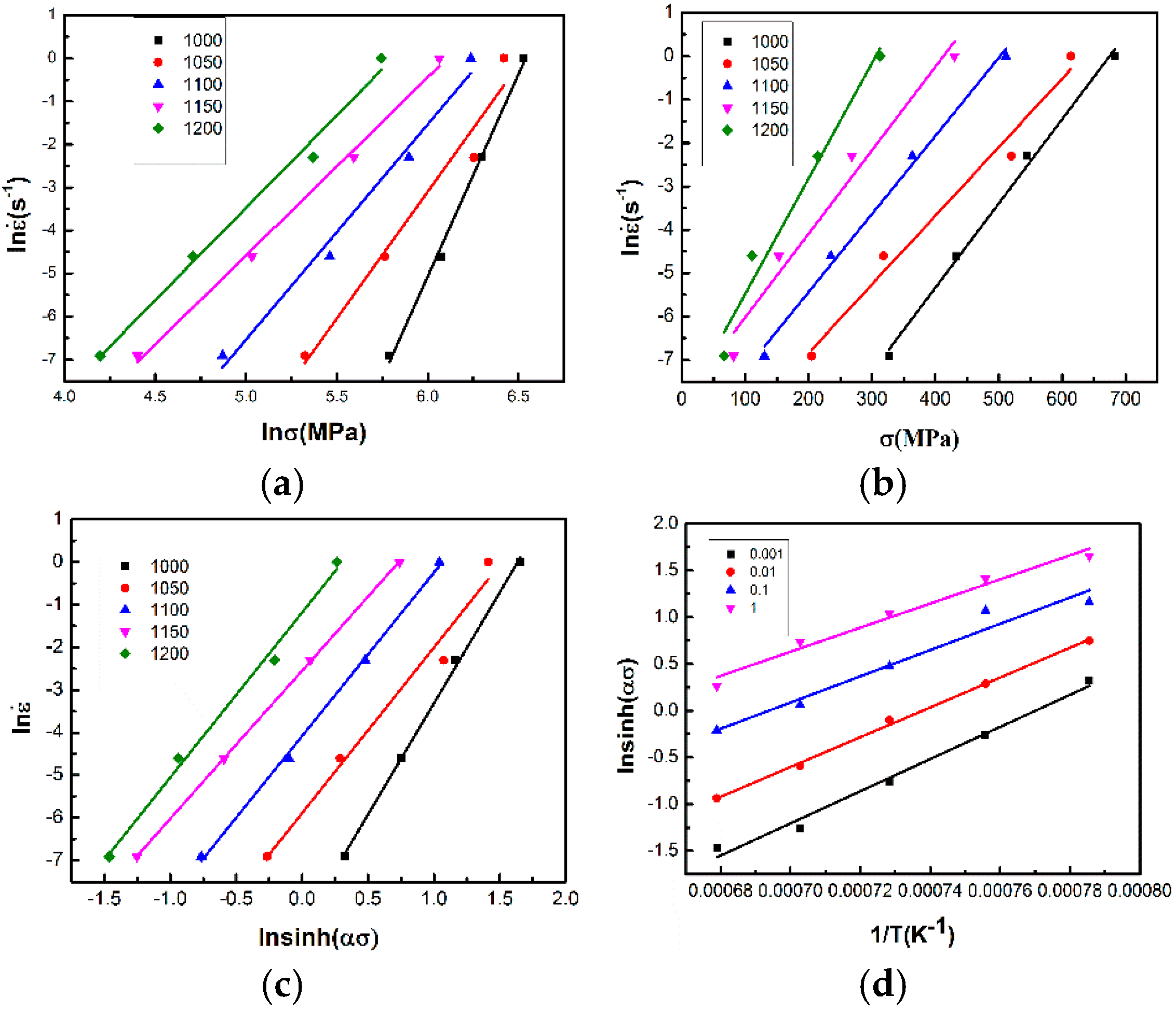
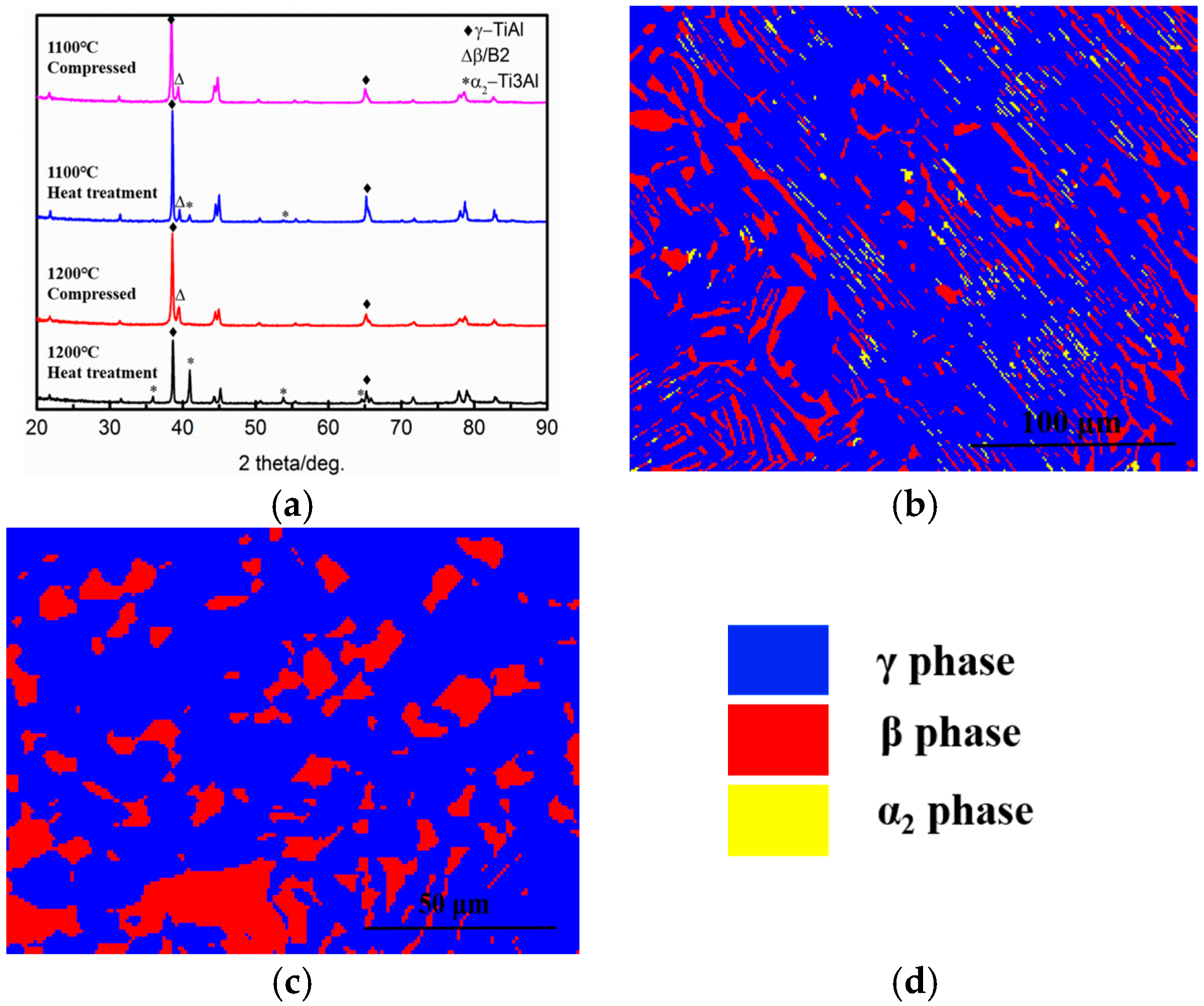

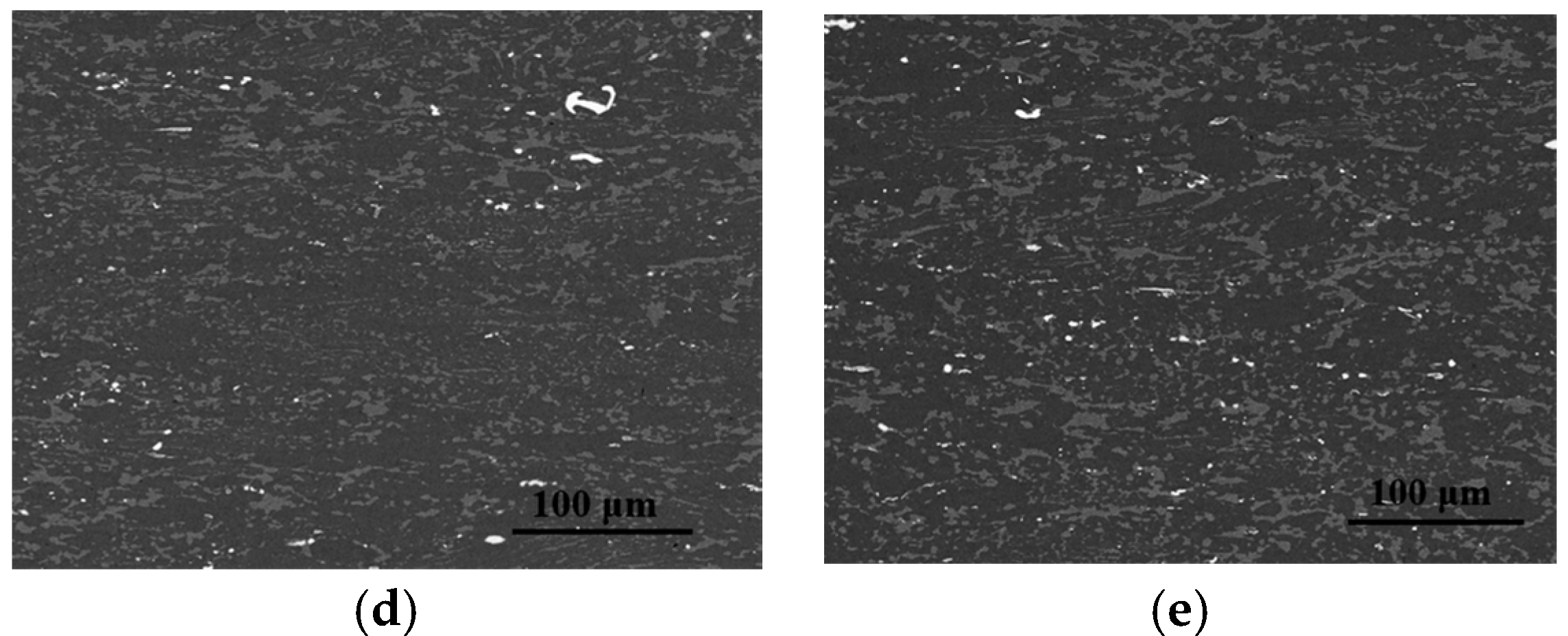
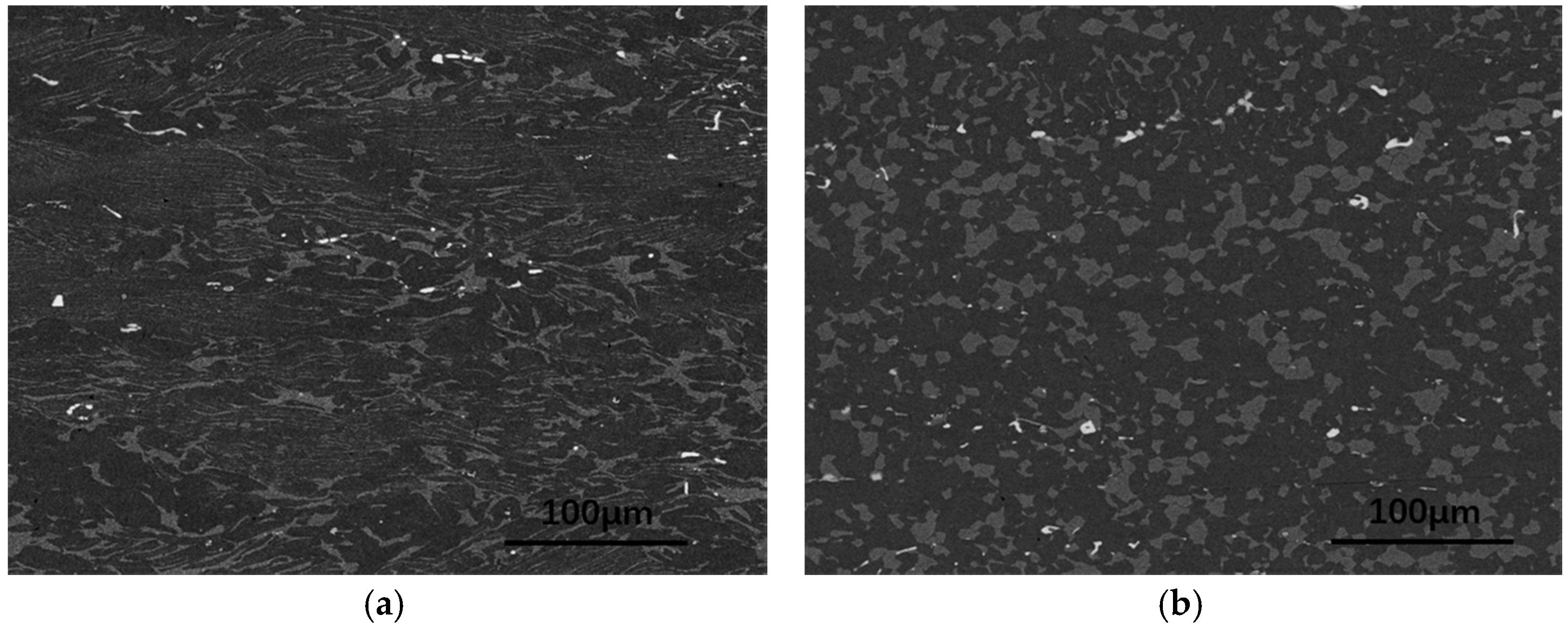
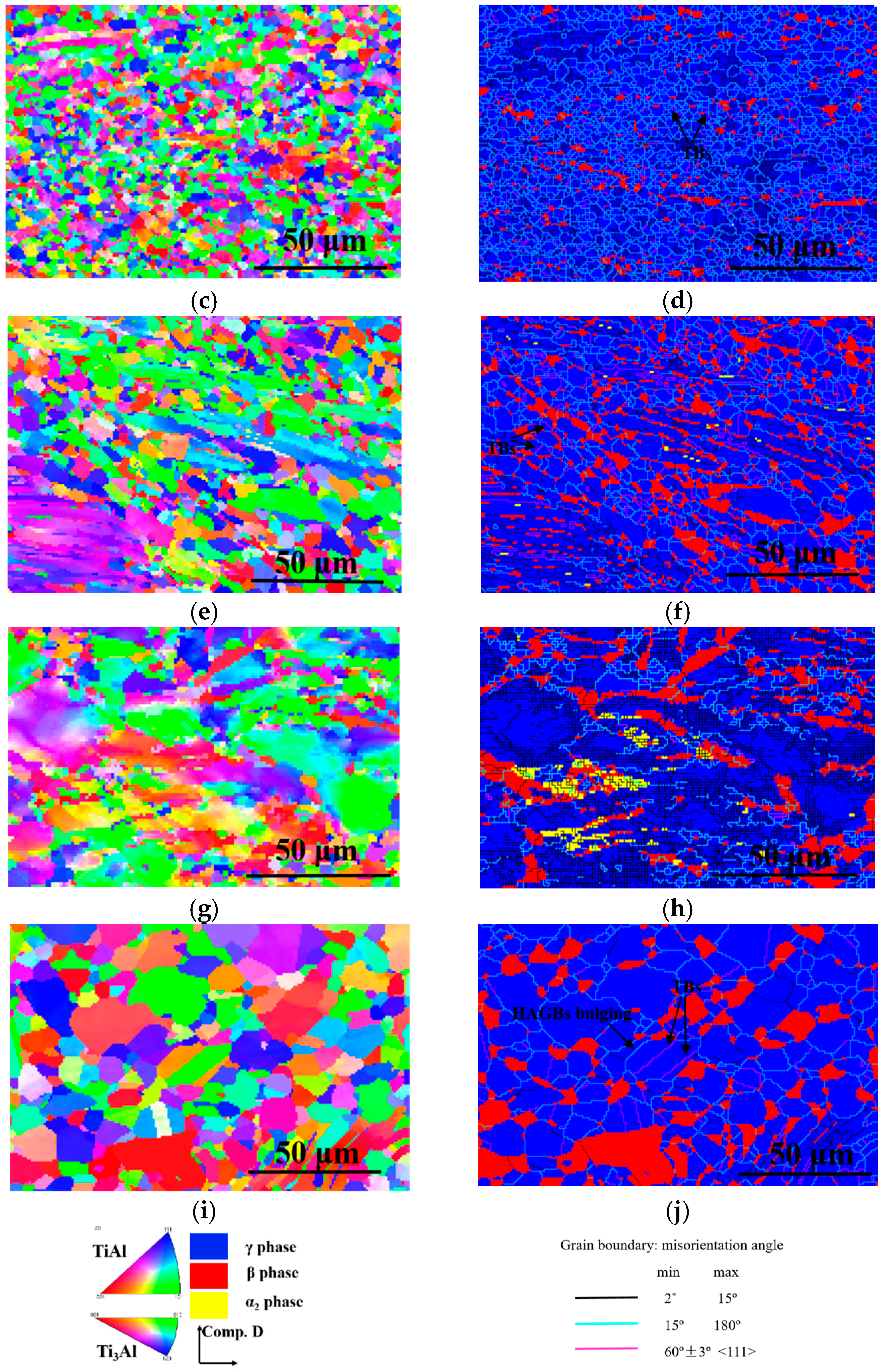

| Element | Al | Nb | W | B | Y | Ti |
|---|---|---|---|---|---|---|
| at % | 44.43 | 8.40 | 0.21 | 0.19 | 0.28 | Bal. |
| Parameters | 1000 °C | 1050 °C | 1100 °C | 1150 °C | 1200 °C |
|---|---|---|---|---|---|
| 0.001 s−1 | 0.05594 | 0.01272 | 0.01219 | 0.0136 | 0.00804 |
| 0.01 s−1 | 0.05747 | 0.01574 | 0.01651 | 0.01621 | 0.01039 |
| 0.1 s−1 | 0.06517 | 0.07555 | 0.01843 | 0.02057 | 0.01471 |
| 1 s−1 | 0.15034 | 0.12692 | 0.0619 | 0.08271 | 0.01828 |
© 2017 by the authors. Licensee MDPI, Basel, Switzerland. This article is an open access article distributed under the terms and conditions of the Creative Commons Attribution (CC BY) license (http://creativecommons.org/licenses/by/4.0/).
Share and Cite
Xiang, L.; Tang, B.; Xue, X.; Kou, H.; Li, J. Characteristics of the Dynamic Recrystallization Behavior of Ti-45Al-8.5Nb-0.2W-0.2B-0.3Y Alloy during High Temperature Deformation. Metals 2017, 7, 261. https://doi.org/10.3390/met7070261
Xiang L, Tang B, Xue X, Kou H, Li J. Characteristics of the Dynamic Recrystallization Behavior of Ti-45Al-8.5Nb-0.2W-0.2B-0.3Y Alloy during High Temperature Deformation. Metals. 2017; 7(7):261. https://doi.org/10.3390/met7070261
Chicago/Turabian StyleXiang, Lin, Bin Tang, Xiangyi Xue, Hongchao Kou, and Jinshan Li. 2017. "Characteristics of the Dynamic Recrystallization Behavior of Ti-45Al-8.5Nb-0.2W-0.2B-0.3Y Alloy during High Temperature Deformation" Metals 7, no. 7: 261. https://doi.org/10.3390/met7070261





